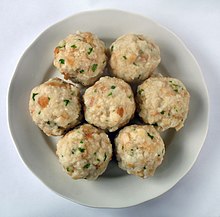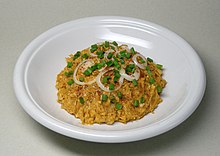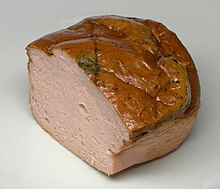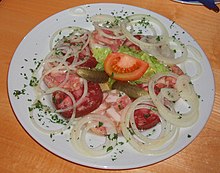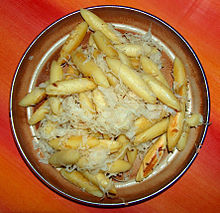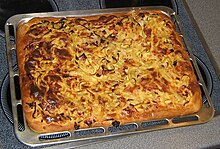Bavarian cuisine
The Bavarian cuisine is a hearty, peasant origins in the kitchen. Characteristic of the Bavarian cuisine are the numerous meat and roasts , dumpling dishes and desserts .
But the Bavarian dukes and especially the Wittelsbachers developed Bavarian cuisine further and refined it in order to make it acceptable. This kitchen found its way into middle-class households, especially in cities, since the 19th century. The (old) Bavarian cuisine is closely related to the Bohemian and Austrian cuisine (including the Tyrolean and Salzburg cuisine) not only because of the family relationships between the Wittelsbach and Habsburg ducal houses . Already in the earliest times, Old Bavaria was in lively exchange with its direct neighbors due to its close linguistic, cultural and political affinity to Austria, and this also in culinary terms.
The two other tribes in Bavaria have developed their own character in the development of their own kitchen, although there is also a certain relationship with the Franconian cuisine and the Swabian cuisine . A Bavarian specialty is the snack , usually a hearty snack , originally between breakfast and lunch , or even more frequently between lunch and dinner was served.
Traditional dishes
Since the late 18th century, regional kitchens were increasingly emphasized in the countries of the German Empire , with particular attention being paid to larger cities. In the 19th century cookbooks called “Bavarian”, both rustic, hearty dishes based on the style of home cooking are published as well as dishes based on the model of French cuisine . The focus was on pastries and dumplings . Meat was only Sunday food for the common people, including the common bourgeoisie.
The 19th century cookbooks contain numerous recipes for soups with dumplings. The meat recipes refer primarily to beef and veal , with cooked beef being an everyday item. When pork mainly played suckling a larger role. “The use of offal and the entire slaughter animal - especially the calf - from head to toe could be considered a peculiarity of the recipe collections in Bavarian cookbooks. Udders, tripe , calf's head, calf feet, etc. a. have now become the sought-after “delicacy” in a revitalized Bavarian regional kitchen via the 'poor people's kitchen' (...). (...) The large number of jellies , prepared sweet and sour, also seems to have been a specialty of Bavarian cuisine. "
Dumplings and noodles were traditional fasting foods in Bavaria. At the end of the 19th century, pork knuckles with dumplings were considered a typical Bavarian regional dish. It was not until 1857 that the Munich white sausage was "invented". Recipes for mixed vegetables are rare in the cookbooks, and stews hardly play a role, although the Pichelsteiner stew is said to have been introduced in Eastern Bavaria in 1847 . In the 19th century, the majority of Bavarians still mainly ate sauerkraut and beets as vegetables . French influenced dishes such as ragouts , fricassee and Böfflamot ( Boeuf à la Mode , also Bifflamott , spiked and marinated beef). The latter was initially a meal only for the nobility, but then became a typical middle-class lunch.
In a report from 1860 it says: “Characteristic of the diet of the rural people in all of Upper Bavaria is the almost exclusive dominance of flour, milk and lard dishes with the addition of vegetables and the restriction of the consumption of meat dishes to the five highest festival times of the year: Carnival, Easter, Whitsun, Kirchweih and Christmas (...) ”.
Munich cuisine
The cuisine of the residents of the state capital differed from the everyday food of the rural population mainly due to the significantly higher proportion of meat. In Munich, a larger part of the population could afford a piece of beef every day, and roast veal was preferred on public holidays. In 1840/41, a total of 76,979 calves were slaughtered in Munich, which at that time had around 83,000 inhabitants, i.e. statistically about one calf per person. The number of cattle slaughtered was around 20,000. Sausages made from veal were particularly popular .
That was by no means standard for rural cuisine in Bavaria at the time. It was not until the 19th century that potatoes , starting from Munich, were gradually accepted in the kitchens of the rural population, until then porridges and soups dominated, and meat consumption was also limited to a few Sundays per year for the poorer parts of the population.
The typical Munich cuisine with its emphasis on meat did not always meet with acceptance among non-residents. One author wrote in a publication about Munich in 1907: “The 'Munich Kitchen' is mainly about the 'Ewig Kälberne'. In no city in the world is so much veal consumed than in Munich (...) Even breakfasts consist mainly of veal in all possible forms of preparation (...) mainly sausages and veal entrails! (...) At lunchtime and in the evening it is teeming with calves of all kinds (...) And the Munich innkeepers talk about a 'rich selection of dishes' without realizing that the one-sidedness of the 'Munich veal kitchen' can no longer be surpassed! "
Overview
Soups and stews
- bread soup
- Semolina dumpling soup
- Wedding Soup
- liver dumpling soup
- Liver sparrow soup
- Pancake soup
- Pichelsteiner
- Ritschert
- Sour soup
- Mushroom soup with bread dumplings
- Bacon Dumpling Soup
Main courses
- Böfflamott ("Boeuf à la mode")
- Bröselschmarrn
- Potato dumplings
- Meatballs
- Kalbsvögerl
- hash browns
- Kasnocken
- Krautwickerl
- Boiler meat
- Crown meat
- Milli cream strudel
- Munich onion meat - regional onion meat variant
- Reiberdatschi
- Sauerbraten
- Sour Lüngerl
- Slaughter bowl
- Lard noodles
- pork roast
- pork
- Suckling pig
- Stick fish
- Surbraten / Surhaxe, roast or knuckle made from cured pork
- Plate meat
Side dishes
- Red cabbage
- Gwixte (dumplings) as an accompaniment to smoked meat
- Hops asparagus
- Rice dumplings
- sauerkraut
- Schuxen
- dumplings
- spaetzle
- asparagus
Snack
- Bavarian blue cheese
- Pretzels
- lard
- Potatoecheese
- Horseradish
- Obazda
- Radi
- Radishes
- Sweet mustard
- White lacquer
Sweets and desserts
- All Souls Braid
- Alpine nuts
- Apple cake
- Extended
- Bavesen
- Apple strudel
- baked apple
- Bee sting
- Steamed noodle
- Yeast dumplings
- Bundt cake
- Hollerkuchl
- Kissinger
- donuts
- Prinzregententorte
- Tube noodles
- pyre
- Smear cake, also stains (similar to a Kolatsche )
- sweet potato noodles
- Zwetschgendatschi
confectionery
Sausages and meat products
- Peasant sigh
- Beer sausage
- Blood sausage
- Yellow sausage
- Smoked
- meatloaf
- Spleen sausage
- Press sack
- Regensburg
- Black smoked
- Stick sausage
- Sulz
- Veal sausage
- Wienerl
- Wool sausage
Salads
- Bavarian potato salad
- Bavarian sausage-salad
- Potato cucumber salad
- coleslaw
- Ox mouth salad
- Sour dumplings
- Sour cheese
- Sour press sack
Regional specialities
Bavarian Swabia
Francs
See also: Franconian cuisine
- Belly piercing la
- Franconian leek soup
- Franconian wood-fired bread
- Franconian dumplings
- Franconian sauerbraten
- Franconian onion cake
- Bread with fruits
- Kissinger
- Knees
- Herb spatula
- Meefischli
- Nuremberg Busserl
- Nuremberg gingerbread
- Nuremberg Rostbratwurst
- Sour tips
- Schäufele
- snowball
beverages
- Bärwurz schnapps
- Bloodroot schnapps
- Gentian schnapps
- Franconian wine
- Light
- March
- Fruit schnapps
- Cyclist
- Soot
- Cola wheat
- Speci
- Strong beer
- Wheat beer
For Bavarian kitchen names see regional kitchen terms .
Web links
- Bavarian specialties and their history
- Bavarian Schmankerl-ABC recipe collection from donaukurier.de





